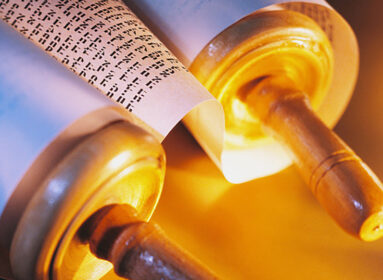The true mission of the Sanctuary – or succah – is to re-create and perfect the earth.
The three major festivals at this time of year – Rosh Hashana, Yom Kippur and Succot – are filled with drama and pageantry; with the piercing sounds of the shofar and the pleasant fragrances of fruits, with the stark white of the Days of Awe and the glorious yellows and greens of the four species on Succot.
The season begins with the first day of the month which is Rosh Hashana, the anniversary of the creation of the world. The Bible describes it as a “day of the terua [broken sighing and sobbing sounds] of the shofar unto you” (Numbers 29:1).
Is it not strange that the Bible marks our remembrance of creation – world and light – with sounds from a ram’s horn reminiscent of groans and wails? I suggest that the Bible is acknowledging the fact that our world is a vale of tears, that human beings are weak and sinful, and live in the shadow of inevitable death.
But there is another sound of the shofar – the exultant tekiya, which the Bible ordains is to be heard on Yom Kippur (10 Tishrei) on the 50th Jubilee year, during the celebration which marks the return of every individual to his familial homestead, frees all slaves and rescinds all debts, declaring liberty throughout the Land (Leviticus 25:8-13).
This victorious sound reflects the fundamental message of Judaism, the fact that the human being is not only formed from the dust of the earth but has also been “inspirited” by the eternal breath of the Divine. The Jubilee year expresses our faith – which is a divine promise – that human beings have the innate power to redeem themselves and the world, to re-create both the kingship of God and to bring about a perfected planet of peace and security which our prophets call the Messianic Age.
What we must do, however, is to develop the God rather than the beast within us by studying and practicing the teachings of God’s Torah. And because we believe that the perfection of the world is within our grasp, we add two exultant tekiya sounds to every broken terua when we blow the shofar on Rosh Hashana. With these sounds we usher in our days of repentance.
Yom Kippur is the Day of Forgiveness. Hopefully by then we shall have successfully reached out to God, and experienced the nearness and goodness of His Presence. Yom Kippur is the climax of this magnificent feeling. It is not a sad fast day, but a joyous, liberating one; we become freed from the blandishments of food, drink and sexual relationships so that we can fully dwell – for a 25-hour period – in the house of God, “in order to see the sweetness of the Lord and to seek him out in His Tent” (Psalm 27). On Yom Kippur everyone becomes transported to the “world to come,” the world of souls, where the souls of the dead and the souls of the living exist in a totally separate dimension.
With the advent of Succot four days later, we are ready to bring our newfound spirituality into this physical world, to re-create and perfect it. We leave our homes and enter a succah, symbolic of the tabernacle/sanctuary/Holy Temple that we are commanded to build on earth so that the Divine might dwell with humanity. That Tabernacle is not only the earthly abode for God and Israel, it is a foretaste of a world at peace, a messianic age.
God initially appointed Bezalel as the architect of the Sanctuary. He “filled him with the spirit of God in wisdom, understanding and knowledge” Exodus 31:2-3). In Proverbs (3:19-20) the text describes how the Lord “established the earth with wisdom, set up the heavens with understanding, and split the deep to give forth water and the heavens to gently drop dew with knowledge.”
Hence, the true mission of the Sanctuary – or succah – is to re-create and perfect the earth.
That’s why its architect had to be endowed with the same attributes the Almighty used to create the world.
And so on Succot we bring special vegetation – the Four Species – into the Synagogue/Temple, through whose vegetable roof we can see the stars.
And on the last day of the festival – Shmini Atzeret-Simchat Torah – we pray for God’s life-giving waters and take Torah scrolls out into the streets so that every human being may accept the yoke of the heavenly kingship. So we have come full circle advancing from the broken terua to the glorious redemption of the world.
Rabbi Shlomo Riskin is chancellor of Ohr Torah Stone and chief rabbi of Efrat, Israel.








 Southern New England Jewish Ledger
Southern New England Jewish Ledger











